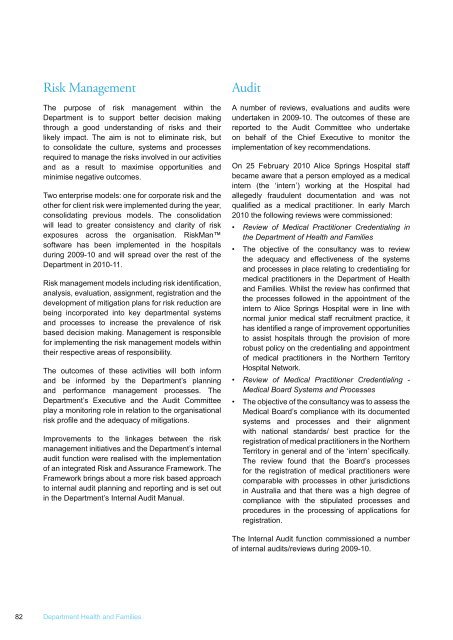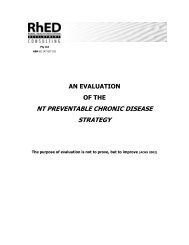DHF Annual Report 2009 - NT Health Digital Library - Northern ...
DHF Annual Report 2009 - NT Health Digital Library - Northern ...
DHF Annual Report 2009 - NT Health Digital Library - Northern ...
You also want an ePaper? Increase the reach of your titles
YUMPU automatically turns print PDFs into web optimized ePapers that Google loves.
Risk ManagementThe purpose of risk management within theDepartment is to support better decision makingthrough a good understanding of risks and theirlikely impact. The aim is not to eliminate risk, butto consolidate the culture, systems and processesrequired to manage the risks involved in our activitiesand as a result to maximise opportunities andminimise negative outcomes.Two enterprise models: one for corporate risk and theother for client risk were implemented during the year,consolidating previous models. The consolidationwill lead to greater consistency and clarity of riskexposures across the organisation. RiskMansoftware has been implemented in the hospitalsduring <strong>2009</strong>-10 and will spread over the rest of theDepartment in 2010-11.analysis, evaluation, assignment, registration and thedevelopment of mitigation plans for risk reduction arebeing incorporated into key departmental systemsand processes to increase the prevalence of riskbased decision making. Management is responsiblefor implementing the risk management models withintheir respective areas of responsibility.The outcomes of these activities will both informand be informed by the Department’s planningand performance management processes. TheDepartment’s Executive and the Audit Committeeplay a monitoring role in relation to the organisationalImprovements to the linkages between the riskmanagement initiatives and the Department’s internalaudit function were realised with the implementationof an integrated Risk and Assurance Framework. TheFramework brings about a more risk based approachto internal audit planning and reporting and is set outin the Department’s Internal Audit Manual.AuditA number of reviews, evaluations and audits wereundertaken in <strong>2009</strong>-10. The outcomes of these arereported to the Audit Committee who undertakeon behalf of the Chief Executive to monitor theimplementation of key recommendations.On 25 February 2010 Alice Springs Hospital staffbecame aware that a person employed as a medicalintern (the ‘intern’) working at the Hospital hadallegedly fraudulent documentation and was not 2010 the following reviews were commissioned: the Department of <strong>Health</strong> and Families The objective of the consultancy was to reviewthe adequacy and effectiveness of the systemsand processes in place relating to credentialing formedical practitioners in the Department of <strong>Health</strong>the processes followed in the appointment of theintern to Alice Springs Hospital were in line withnormal junior medical staff recruitment practice, itto assist hospitals through the provision of morerobust policy on the credentialing and appointmentof medical practitioners in the <strong>Northern</strong> TerritoryHospital Network. Medical Board Systems and Processes The objective of the consultancy was to assess theMedical Board’s compliance with its documentedsystems and processes and their alignmentwith national standards/ best practice for theregistration of medical practitioners in the <strong>Northern</strong>The review found that the Board’s processesfor the registration of medical practitioners werecomparable with processes in other jurisdictionsin Australia and that there was a high degree ofcompliance with the stipulated processes andprocedures in the processing of applications forregistration.The Internal Audit function commissioned a numberof internal audits/reviews during <strong>2009</strong>-10.82Department <strong>Health</strong> and Families
















